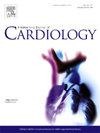Prevalence of hypertriglyceridemia and its association with extreme cardiovascular risk in patients with acute and chronic coronary syndrome enrolled in a cardiac rehabilitation program
IF 3.2
2区 医学
Q2 CARDIAC & CARDIOVASCULAR SYSTEMS
引用次数: 0
Abstract
Background
Prevalence of hypertriglyceridemia in patients with Acute and Chronic Coronary Syndrome (ACS and CCS, respectively) in the current era of Low-Density Lipoprotein Cholesterol (LDL-C) targets remains unknown. This study aimed to evaluate the prevalence of triglyceride (TG) levels above 150 mg/dL in ACS and CCS patients enrolled in a Cardiac Rehabilitation (CR) program and to explore its association with extreme cardiovascular (CV) risk.
Methods
We included 905 ACS/CCS patients who participated in the CR program at Niguarda Hospital (Milan) between January 1, 2012, and March 28, 2024. Data on demographic, clinical, and laboratory variables were collected. Extreme CV risk was defined as the occurrence of a CV event within two years or the presence of peripheral artery disease or multivessel coronary involvement.
Results
TG levels significantly decreased during the CR period (median 116.5, I-III quartiles 87–115 vs. 100, 80–133 mg/dL, p < 0.001), as did LDL-C levels (106.8 ± 39.3 vs. 64.4 ± 24.9 mg/dL, p < 0.001). At the end of CR, 17.6 % of patients had TG levels ≥150 mg/dL (15.0 % among those who reached the LDL-C target). In multivariable analysis, each 10 mg/dL increase in TG was associated with a 4.6 % increased risk of extreme CV risk (OR 1.046; 95 %CI 1.007–1.085; p = 0.019). Additionally, hypertriglyceridemia (TG >150 mg/dL) increased the risk of extreme CV risk by 81.5 % (OR 1.815; 95 %CI 1.096–3.007; p = 0.021).
Conclusions
Despite high-intensity statin therapy and low LDL-C targets, a significant proportion of patients in CR still exhibited elevated TG levels. Both TG levels and hypertriglyceridemia were strongly associated with the presence of extreme CV risk.

参加心脏康复计划的急慢性冠状动脉综合征患者的高甘油三酯血症患病率及其与极端心血管风险的关系
背景:在当前低密度脂蛋白胆固醇(LDL-C)靶点时代,高甘油三酯血症在急性和慢性冠脉综合征(分别为ACS和CCS)患者中的患病率尚不清楚。本研究旨在评估参加心脏康复(CR)项目的ACS和CCS患者甘油三酯(TG)水平高于150 mg/dL的患病率,并探讨其与极端心血管(CV)风险的关系。方法:我们纳入2012年1月1日至2024年3月28日在米兰Niguarda医院参加CR项目的905例ACS/CCS患者。收集了人口统计学、临床和实验室变量的数据。极端心血管危险被定义为两年内发生一次心血管事件或存在外周动脉疾病或多支冠状动脉受累。结果:TG水平在CR期间显著降低(中位数116.5,I-III四分位数87-115对100,80-133 mg/dL, p 150 mg/dL),使极端CV风险增加81.5 % (OR 1.815;95年 %可信区间1.096 - -3.007; = 0.021页)。结论:尽管高强度他汀类药物治疗和低LDL-C靶点,相当比例的CR患者仍然表现出TG水平升高。TG水平和高甘油三酯血症与极端CV风险的存在密切相关。
本文章由计算机程序翻译,如有差异,请以英文原文为准。
求助全文
约1分钟内获得全文
求助全文
来源期刊

International journal of cardiology
医学-心血管系统
CiteScore
6.80
自引率
5.70%
发文量
758
审稿时长
44 days
期刊介绍:
The International Journal of Cardiology is devoted to cardiology in the broadest sense. Both basic research and clinical papers can be submitted. The journal serves the interest of both practicing clinicians and researchers.
In addition to original papers, we are launching a range of new manuscript types, including Consensus and Position Papers, Systematic Reviews, Meta-analyses, and Short communications. Case reports are no longer acceptable. Controversial techniques, issues on health policy and social medicine are discussed and serve as useful tools for encouraging debate.
 求助内容:
求助内容: 应助结果提醒方式:
应助结果提醒方式:


